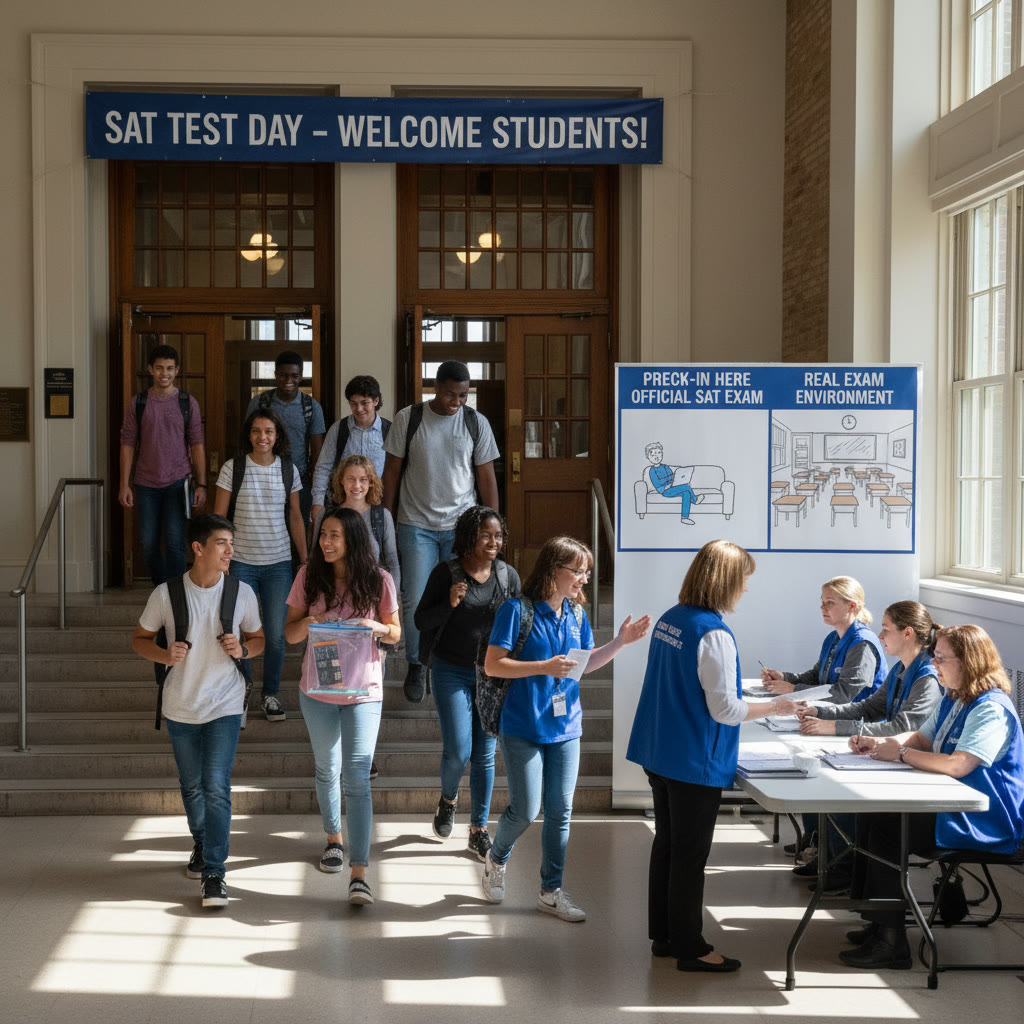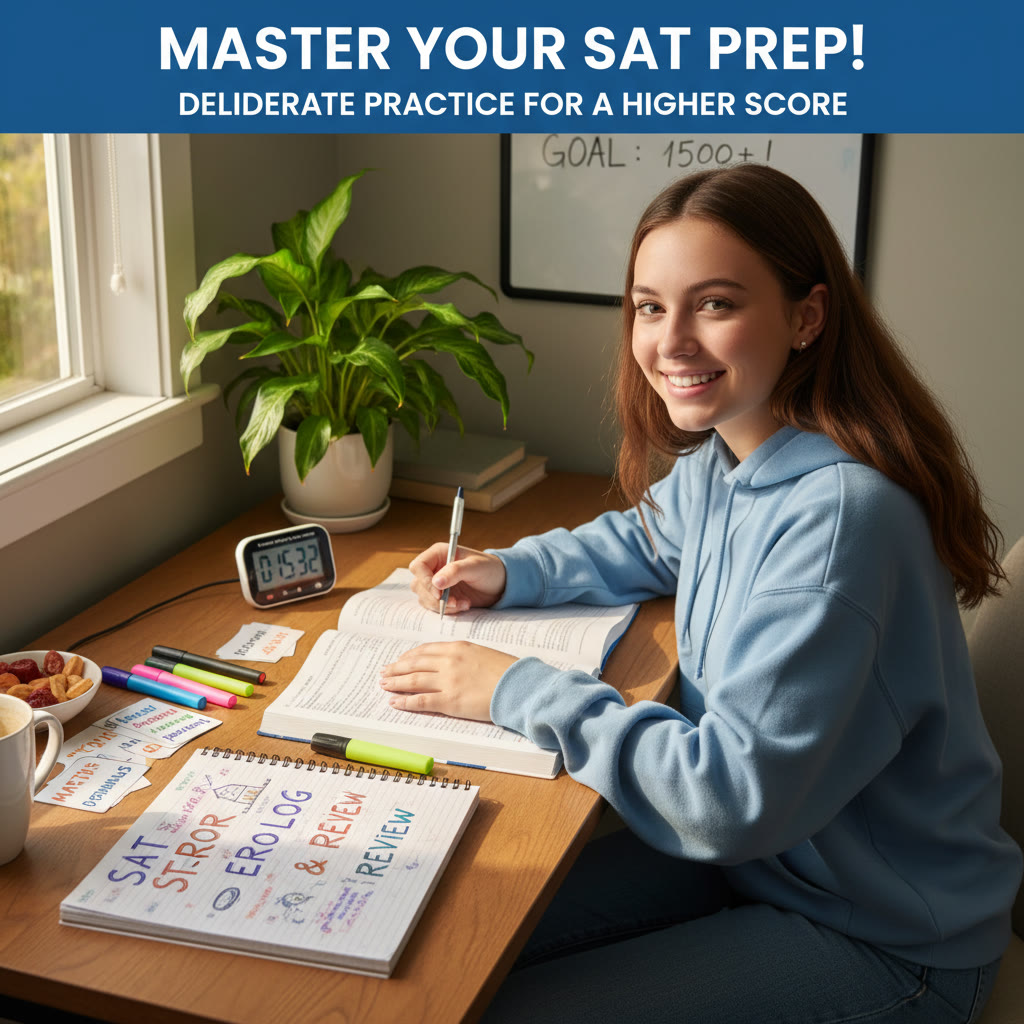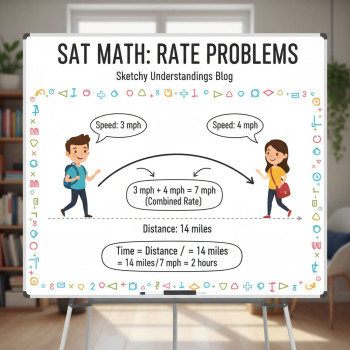The Psychology of SAT Practice Tests vs the Real Exam
Imagine this: you sit down for a timed, full-length SAT practice test on a Saturday afternoon. You’re calm, your desk is tidy, Spotify is playing soft instrumental music, and you finish feeling proud — maybe even optimistic that you’ve landed your dream score. Fast-forward two weeks: test day arrives. The testing center room smells different, there’s a line at check-in, your stomach is tight, and the clock feels faster. Suddenly, the questions don’t seem to unfold the same way they did at home.
That disconnect — where your best practice performance doesn’t map perfectly onto the real exam — is nearly universal. It has less to do with luck and more to do with psychology. Practice tests are invaluable, but they are tools that must be wielded correctly. This post digs into the mental mechanics that make practice tests and the real SAT feel different and shows how to turn practice into reliable transfer: consistent, test-day performance.
Why this matters
Students often fall into two traps: mistaking practice-test scores for guaranteed results, or discounting practice because it doesn’t feel like the “real thing.” Both positions ignore the psychological layers between what you practice and what you execute. By understanding those layers, you can calibrate practice so that it does more than build skill — it builds resilience, accurate self-knowledge, and exam-ready habits.
The Anatomy of a Practice Test
What a good practice test gives you
At its best, a full-length practice SAT provides three things:
- Assessment: a snapshot of strengths and weaknesses across Reading, Writing & Language, Math (No Calculator), and Math (Calculator).
- Skill rehearsal: repeated exposure to question types, time management practice, and familiarity with instructions and format.
- Feedback loop: data points you can analyze to adjust study plans, identify weak content areas, and refine strategies.
These are the core benefits. A well-constructed practice test, taken seriously, is the single most efficient tool for targeted improvement.
Where practice tests fall short
Despite those benefits, practice tests rarely recreate the totality of test-day experience. Here are common shortcomings:
- Contextual mismatch: at-home or comfortable settings lack the logistics, timing, and social dynamics of a test center.
- Emotional buffering: low-stakes environments produce weaker physiological responses (less adrenaline, different heart-rate patterns), so performance under pressure is under-simulated.
- Overfitting: repeated practice on the same question patterns can create a sense of mastery that doesn’t generalize because your brain learned the practice test rather than the underlying strategies.
- Feedback illusions: instant checking or pausing mid-test (common at home) interferes with test conditions and trains habits that aren’t allowed during the real exam.

What Changes in the Real Exam
Stakes and the pressure curve
On test day, stakes feel personal in a way they rarely do during practice. Admissions, scholarships, and months of preparation converge into a few hours. That perceived importance changes your body’s arousal level — the familiar inverted-U relationship between arousal and performance (Yerkes-Dodson Law). A little adrenaline can sharpen focus; too much can narrow attention and reduce working memory capacity, causing normally automatic reasoning to feel slow.
Time perception and pacing
Under stress, subjective time often compresses. Fifteen minutes can feel like ten; a 25-minute reading section can feel like a sprint. That compression changes how you pace. Students who are normally patient rush and make avoidable mistakes. Conversely, those who fear running out of time may under-invest in harder items that would yield more points.
Environmental and social factors
Small changes matter: the chair may be different, the test room temperature may be off, there may be noise in the hall, or the clock may be positioned in a place that makes checking time awkward. Social cues matter too — seeing other students flipping pages quickly can induce haste. These cues produce micro-behaviors (shallow breathing, fidgeting) that subtly degrade cognitive performance.
Side-by-Side: Practice Test vs Real Exam
| Factor | Typical Practice Test | Real Exam | Psychological Impact |
|---|---|---|---|
| Stakes | Low to medium (diagnostic or low-stakes) | High (perceived consequences) | Higher arousal, potential working memory reduction |
| Environment | Controlled, familiar | Unfamiliar, variable | Increased distraction and sensory mismatch |
| Timing habits | Often violated (pauses, breaks, music) | Strict, continuous timing | Need for disciplined pacing and calibration |
| Feedback | Immediate and iterative | No immediate feedback | Changes approach to risk and guessing |
| Emotional state | Relaxed | Elevated anxiety | Impacts attention control and decision-making |
The Cognitive Mechanics Behind the Gap
Transfer-appropriate processing and encoding specificity
Two principles from cognitive psychology explain why practice context matters. Transfer-appropriate processing says performance is best when the cognitive processes used during learning match those used during retrieval. Encoding specificity adds that memory retrieval is aided by contextual cues present during learning. If you always practice with headphones and a snack, your mind learns to rely on those cues. That doesn’t help if they’re absent on test day.
Working memory and anxiety
Anxiety consumes working memory bandwidth. The SAT requires juggling question interpretation, recall of grammar rules or math formulas, and problem-solving steps — all of which draw on working memory. When anxiety occupies that space, even well-practiced procedures can feel foggy. This is why strategies that automate lower-level processes (like systematic problem-setup templates in math) are valuable: they reduce working memory load so you can allocate mental capacity to higher-order thinking.
Metacognition and calibration
Practice tests are as much about building metacognitive accuracy as they are about content knowledge. Calibration — knowing how well you’re actually doing — is often poor. Students overestimate or underestimate their performance because they don’t practice the act of self-assessment under test-like conditions. Effective practice builds accurate gut sense: knowing when to move on, when to guess strategically, and when to invest time on a hard question.
How to Bridge the Gap: Practical, Psychology-Aware Strategies
1. Simulate test conditions faithfully
At least twice in the month before your test, take a full-length SAT under strict conditions: timed sections, official breaks, no music, and the same type of chair/desk position you expect at the center. Remove the comforts you normally allow. This isn’t punishment — it’s training the brain to perform under authentic cues so encoding and retrieval contexts match.
2. Vary practice to avoid overfitting
Don’t do the same style of problems in one sitting. Mix question types and difficulty levels. Interleaving practice forces your brain to classify and select strategies rather than memorize a narrow routine that works only for repeated formats.
3. Build automaticity for routine processes
Automate the steps that don’t require deep thinking: scanning for question types, annotating passages, plugging in numbers, and using scratch-work templates. When low-level skills are automatic, anxiety has less disruptive power.
4. Practice under mild stress
Occasional mild stress helps you adapt. Try timed mini-challenges, practice in a noisy café, or take a test after a brisk walk that raises your heart rate slightly. These stress inoculation techniques make moderate arousal feel less aberrant on test day.
5. Calibrate with deliberate review
Don’t just take practice tests — analyze them. Keep an error log: note the type of mistake (careless slip, time management, conceptual gap), the emotional state at the time, and the corrective action. Over time, patterns emerge and you can design targeted drills.
6. Simulate test-day routines
Practice the morning routine you’ll use on test day: wake-up time, breakfast, travel time, check-in procedure, and the way you’ll manage breaks. A smooth routine reduces uncertainty and decision fatigue.
7. Use breathing and anchoring techniques
Simple physiological strategies work. A 4-4-6 breathing pattern (inhale 4, hold 4, exhale 6) before a section resets your nervous system. Choose a quick grounding ritual to perform between sections — an anchor that says to your body, “You’ve got this.”
8. Get realistic feedback and adaptive help
Raw scores are useful, but meaningful feedback is better. A tutor or coach can observe non-obvious patterns (like repeated misreading of questions under time pressure). Sparkl’s personalized tutoring, which offers 1-on-1 guidance, tailored study plans, and AI-driven insights, can help convert practice-test data into a focused plan that targets both content gaps and psychological vulnerabilities.
A Sample 4-Week Practice-Test Plan (To Close the Gap)
| Week | Focus | Key Activities |
|---|---|---|
| Week 1 | Baseline & Calibration | Full-length diagnostic test under strict conditions; error log; identify 3 top weaknesses |
| Week 2 | Targeted Skill Building | Daily 60-90 min drills on identified weaknesses; 2 timed sections; breathing and pacing practice |
| Week 3 | Mixed Practice & Simulation | Alternate mixed practice sets; one full-length simulation in a new environment (library or testing-space vibe); feedback session |
| Week 4 | Taper & Test-Ready | Light practice, mental strategies, finalize test-day routine; one final full-length under strict timing; focused review of last mistakes |
How to read this plan
The goal is twofold: increase skill and increase transfer. Early weeks fix content gaps; later weeks force retrieval under stress and varied contexts. The final week is about consolidation and confidence.
Mindset and Rituals for Test Day
Adopt a process-oriented mindset
Worrying about score outcomes fuels anxiety. Instead, focus on process metrics you can control: accuracy per minute, number of skipped-but-marked questions, and consistency of your scratch-work. Process orientation reduces outcome pressure and keeps attention on actionable tasks.
Create a compact toolkit
Pack a small toolkit for the morning: a light, familiar breakfast, extra pencils, a watch (if allowed), and a brief list of coping phrases or anchors — short reminders like “Breathe, read, outline, answer.” These tactile cues are calming and remind you to follow practiced steps.
Remember: tests measure performance, not worth
Anxiety magnifies perceived consequences. Practice reframing: the SAT is an important milestone, not a moral judgment. This reframing helps reduce catastrophizing and allows your skills to shine.

Putting It All Together
Practice tests are powerful, but they are not magic. The gap between practice and performance is psychological as much as technical. You can narrow, even close, that gap by treating practice tests as high-fidelity simulations rather than just question farms. Vary conditions, build routine, automate fundamentals, and deliberately expose yourself to mild stress so your brain learns to perform when it counts.
If you find calibration tricky, personalized support speeds the process. Tutors who combine content expertise with psychological coaching — offering 1-on-1 guidance, tailored study plans, and data-driven insights — can transform ambiguous practice data into clear actions. For students who want help aligning practice results with test-day outcomes, working with a service that blends human tutors and AI-driven feedback can accelerate progress and reduce wasted study time.
Final Thoughts
The best practice test is one that teaches you something useful about both your knowledge and your psychology. When you leave practice sessions with an error log, a ritual to deploy under pressure, and a clear plan for the next week, you’re doing more than preparing — you’re training your testing mind. That’s the real secret to consistent SAT performance: not just knowing the right answers, but doing the right things under pressure.
Test day is a performance. Treat your practice tests like dress rehearsals: simulate the conditions, correct the flubs, steady your nerves, and walk into the exam with a toolkit that makes your knowledge accessible. With intentional practice and a few psychology-informed habits, your practice scores will begin to look a lot more like your real score — and that feeling of alignment is enormously liberating.
Good luck, and remember: steady preparation beats panic. Use your practice tests wisely, and let them teach both your brain and your heart how to show up on the day that matters.














No Comments
Leave a comment Cancel